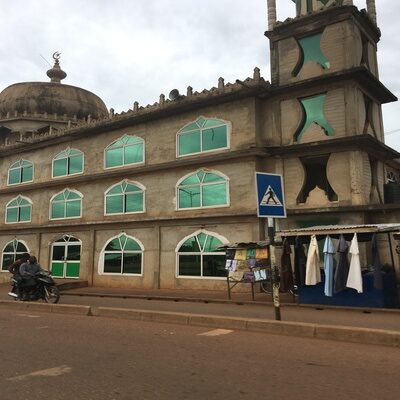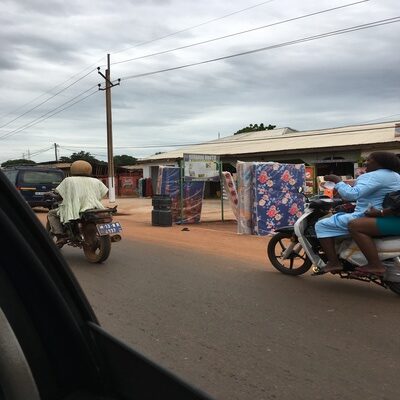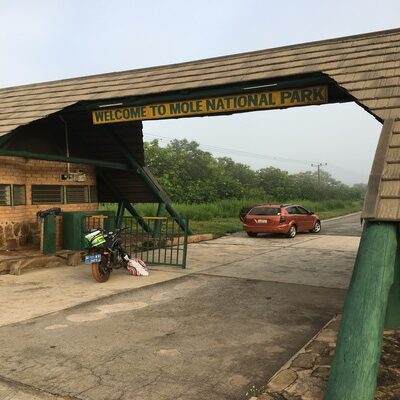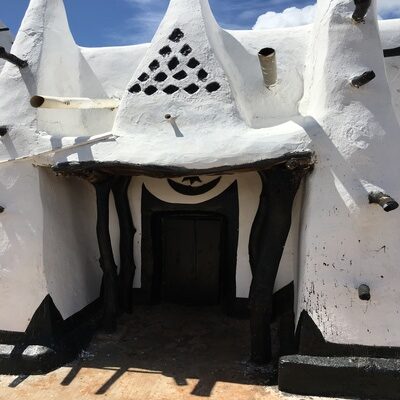For three weeks, Pan-Africa Football is in Ghana to visit just about all corners of the country to experience its culture, and of course its football. We will be traveling back and forth from the capital Accra to other prominent locations across Ghana, including the Ashanti Region, Tamale, the Bono Region and the Cape Coast. Read on for blog number three as PAF takes a look at the hub of the northern half of Ghana, the city of Tamale.

One of the many mosques in Tamale
“Look”, Salah said as he gestured to the changing vegetation outside the window. We were now over six hours into our bus ride, and he had prepared me for the noticeable difference between the southern regions of Ghana and the northern half of the country. The palm trees that were more typical of the tropical Southern areas were now giving way to grasslands and savannahs, a trend that would only increase as we approached closer to Tamale. After over thirteen hours on the bus, we finally arrived in a location that seemed like another country compared to Accra. Along with the increase in savannahs and open spaces, the number of cars decreased substantially with motorcycles the preferred method of transportation and mosques outnumbered churches as well.



Above: Several sights from Tamale including the vehicles and motorcycles that are popular in the city as well as an example of the grasslands that are all over the surrounding region.
We got settled in at a guest house after arriving in the evening and set out the next morning to look at the city, which is Ghana’s third largest with just under a million inhabitants. When it comes to football, Tamale is best known for being the home of Ghana’s most legendary footballer, Abedi Ayew, or as he is professionally known, Abedi Pele. Long time national team members Mubarak Wakaso and Abdul Majeed Waris are also among the well-known players to emerge from a city that continues to escalate in its development as the hub of the area. Before we got to our first location, our driver Stallon stopped by a local food stand where we continued our sampling of African cuisine with my first attempt at guinea fowl, one of the highlights out of the meals I had on the trip.
The first landmark we set out to see after eating was the Tamale Sports Stadium, known as the Aliu Mahama Sports Stadium since December 2017 after the late former Vice President of Ghana. Completed in 2008 in time for Ghana’s hosting of the 2008 Africa Cup of Nations, the 20,000 capacity venue is perfectly enclosed to create a rocking atmosphere when full along with a high quality fitness center for its tenants. We were able to get inside and take plenty of pictures before the local top club side, Real Tamale United, arrived for training. Having just earned promotion to the Ghana Premier League for the 2021-22 season, Ghana’s top tier will have a team representing the northern half of the country for the first time since Wa All Stars from the Upper West Region competed in the 2018 season.



Pictures taken by PAF from inside the Aliu Mahama Sports Stadium, which opened in 2008 for Ghana’s hosting of that year’s edition of the Africa Cup of Nations

Abedi Ayew “Pele”, regarded as Ghana’s best ever player and the father of current national team stars André Ayew and Jordan Ayew, spent his formative years in Tamale.

Current Ghana international Mubarak Wakaso is another famous footballing native of Tamale
Next up was a focus on some of the cultural and natural landmarks in the city after checking out the stadium. The city is known for its art museums and initiatives that were started by local artist Ibrahim Mahama, with his Savannah Center for Contemporary Art (SCCA) the first museum we visited followed by a visit of Mahama’s display of six airplanes at Redclay Studio. Selling his original artwork for $1 million, Mahama purchased the used planes that all range from different eras to display at the studio to encourage young artists in the area to pursue their artistic vision. Visitors can also view displays from European artists that are partnered with Mahama’s project, and we viewed several of those created by creatives from Denmark in particular.

The Savannah Centre for Contemporary Art building

A display at the SCCA that includes a lunar sample from one of the Apollo space missions

An airplanes on display at one of Ibrahim Mahama’s museum sites
As a visitor from the United States, I had to see if I could look at some wildlife and we ventured into the vast Savannah Region to visit the Mole National Park. However, there was not enough time to visit for an extended period and we did not see any of the elephants that the park was known for during our time there. On our way back to Tamale we stopped by the village of Larabanga to look at one of the oldest mosques in West Africa, which was completed 600 years ago in 1421. The Larabanga Mosque has been maintained from generation to generation in the small village with a baobab tree sitting right next to it that sprouted from the spot where the original builder was buried.

Gate to the Mole National Park, known for its population of African bush elephants

Village dwellings in the Savannah Region

An entrance to the Larabanga Mosque, a landmark built in 1421 that is now over 600 years old
Tamale was a truly interesting spot that offers plenty of footballing, cultural and natural landmarks for any visitors. The city marks the transition from the more urban and tropical southern half of Ghana to the rural grasslands of its northern half. Salah and I headed out on yet another extended bus ride to head over to our next location and the setting of Pan-Africa Football’s next blog, the Bono Region.





